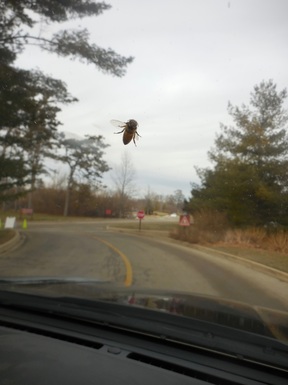|
Here in Chicago we've had ten days of above average temperatures, reaching up to 10°C this Sunday (that’s 50°F for those of us still in need of fully adopting the metric system). A great way to get a perspective on global climate and temperature trends is to look at the maps available from NOAA (the National Oceanic and Atmospheric Administration). Here's a map comparing December 2015 to average December temperatures. https://www.ncdc.noaa.gov/sotc/global/ Notice how the Midwest is looking decidedly red? We'll have to wait to see the map for this January. We've had some colder weather as well in January, so it will be interesting to see how it compares. This warmer weather has me thinking about the ways that our local ecology is affected by unseasonal warmth. Species that are normally hunkered down or dormant may be receiving cues that don't line up with an average January. On a weekend trip to the Morton arboretum, the sled dogs there for a special event had to "sled" without snow (they pulled wheeled carts instead). Other signs, as well, suggested something other than a January afternoon. A honeybee decided to land on our windshield while the car was parked. Worker bees are usually huddled together in their hive during the coldest months. Need a flower fix in January? Witch hazel is a good bet, at least this winter. These flowers look to be just starting to open, and although they are small, a little splash of color in winter is still a treat. This is Hamamelis 'Brevipetala,' which is a cross between an Asian and a North American species of witch hazel. Although considered a winter-flowering species, I'm not sure if you can regularly find it flowering in January or not (perhaps I will have to compare in future years). Even so, what creature might be out and about in winter to pollinate such a flower? Apparently owlet moths, which can be active at night if the temperature is above freezing. Although these moths often eat sap from damaged trees, they have also been observed visiting witch hazel flowers. These industrious moths have the ability to raise their body temperature through shivering, allowing flight when other insects are grounded.
Although there's much to enjoy about a mild winter day, it's not without its concerns. Check out this article from the New York Times about the mild winter in 2012. Early warming can often be followed by freezing temperatures, leaving plants or insects exposed and vulnerable. Have you seen anything that you might normally consider to be a "sign of spring" this winter?
2 Comments
Sara Wyse
2/1/2016 08:48:10 am
We saw a robin out last week; typically they do not return here until around the first day of spring. I know two years ago, many returned early and continued to hang out in groups, typical of their migratory behaviors rather than their foraging, nesting ones. We haven't been much above freezing yet this "spring" (other than this weekend), but we only had 1 week of really cold (-25-40), where we typically have 2-3 weeks of such weather. Can't believe you saw a honeybee!!!
Reply
Abbie Schrotenboer
2/4/2016 04:50:51 pm
Interesting to see. A few robins do regularly stick around the Chicago area for the winter although they tend to be rather scarce until spring.
Reply
Leave a Reply. |
Abbie SchrotenboerI'm a biology professor at Trinity Christian College. I'll be using this page to share interesting stories related to ecology and conservation at Trinity and in the Chicago area (although I might be tempted to expand my geographic focus upon occasion). Archives
December 2020
Categories |



 RSS Feed
RSS Feed
